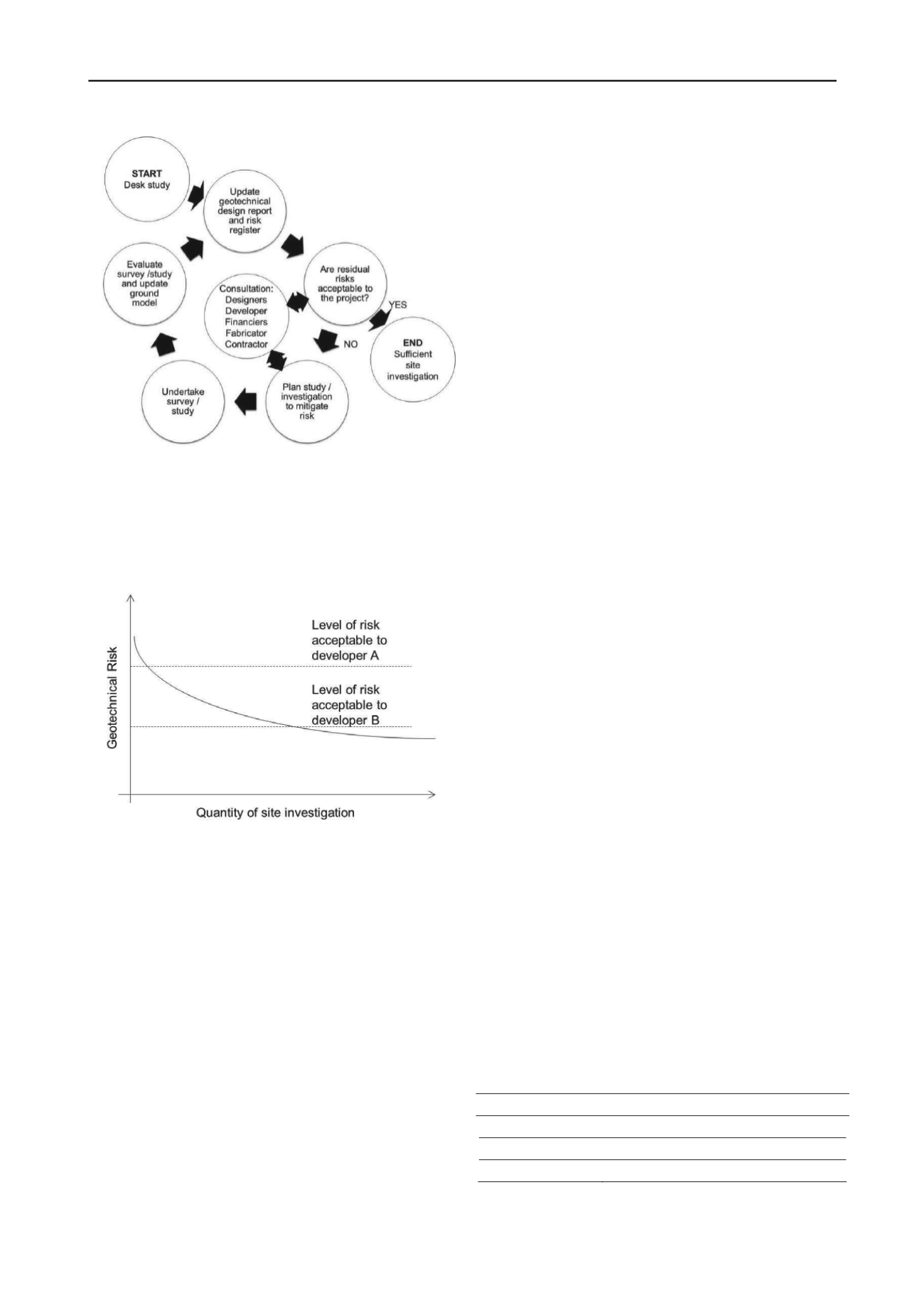
2377
Technical Committee 209 /
Comité technique 209
Figure 1. Risk based approach to managing geotechnical hazards
In managing this risk based approach it is essential that the
designers appreciate that developers will have different
acceptable levels of risk (Figure 2). This level of risk will
depend on developers’ sources of funding, project timescale and
contracting/procurement strategy. The acceptable level of risk
will also change as a project develops.
Figure 2. Acceptable level of geotechnical risk to a developer
3.2
Staged site investigations
All of the projects reviewed in Section 2 had separate stages of
site investigation comprising a geophysical followed by a
geotechnical campaign. However the good practice projects had
a multistage geotechnical campaign. Eurocode 7 (EC7) (BS EN
1997-2:2007) states that “
Ground investigations should
normally be performed in phases depending on the questions
raised during planning, design and construction”.
The code
goes on to define two distinct phases of investigation –
preliminary investigation and design investigation.
The multistage geotechnical investigation allows for a
comparatively cheap ground-truthing geotechnical campaign
early in the design process. This campaign gives the designer
sufficient information to confirm the expected ground model
and develop a preliminary design solution. The design
investigation will then be significantly more effective, since it
can utilise the most effective methods of investigation for the
ground conditions, and fit the foundation type and dimensions
that are being designed.
The strategy outlined in Figure 1 will be most effective when
repeated several times; designers should be wary of trying to
understand all ground based hazards in one stage of
geotechnical investigation. A simple preliminary investigation
combined with the existing understanding of the site will often
provide the best value to the developer at an early stage.
3.3
Develop contracting structure that allows early
appointment of the designer
Many of the example projects detailed in Section 2 had
ineffective site investigations because the detailed designer for
the foundations was not appointed until after all site
investigations had been completed. These projects appointed
engineers solely to organise and supervise a single phase of site
investigation who were not otherwise engaged in planning or
design of the project. “
This practice inhibits continuity or
integration of project development, with the prospect that the
site investigation will not be coupled with other features of the
project planning process and will, in consequence, not provide
adequate answers to vital questions and will not allow
consideration of innovative methods of working
”. This quote
from Muir Wood (Muir Wood 2000) is just as applicable to
offshore wind farm developments as it is to the tunnelling
projects it was originally written to describe.
Instead developers should seek to engage a designer at the
start of the development phase, who has the competence and
ability to provide the geotechnical engineering for the whole
project. This allows the foundation design and the scope of the
site investigation to develop with the project, which mitigates
project risks and delivers cost effective site investigations.
This is the approach taken by most infrastructure projects of
equal size and complexity to these offshore wind developments.
As these projects have demonstrated, this does not prevent the
use of different project procurement mechanisms, provided that
mechanisms such as novation are available to the developer.
4 APPLIED EXAMPLE
The strategy detailed in Section 3 is being applied to the first
project of the Hornsea Round 3 development area as follows.
4.1
Engineering contract setup
For this project, the developer – DONG Energy is using in-
house engineers to undertake the geotechnical design and
engineering. This capability is supplemented by the use of
additional consultants appointed to the projects for long term
positions. This setup gives an integrated approach to
engineering and development. Different parts of the project will
have different procurement strategies; where the developer
chooses not to progress the detailed design in house the design
for that element will be contracted to another party, with the
original in-house design team maintained in a reviewing
capacity.
4.2
Desk study
Prior to the desk study, no geotechnical design parameters were
available. The principal geotechnical risks at this stage are
shown in Table 1. At this point, the site investigations cannot be
specified as the foundation type, ground conditions and design
requirements are not understood.
Table 1. Design parameters and primary geotechnical risks prior to desk
tudy
s
Design parameter
Geotechnical risks
None
Unknown site constraints
Unknown design constraints
Unknown construction constraints
Following completion of a desk study which includes a
review of geological information, design requirements and
possible foundation types and construction considerations,


